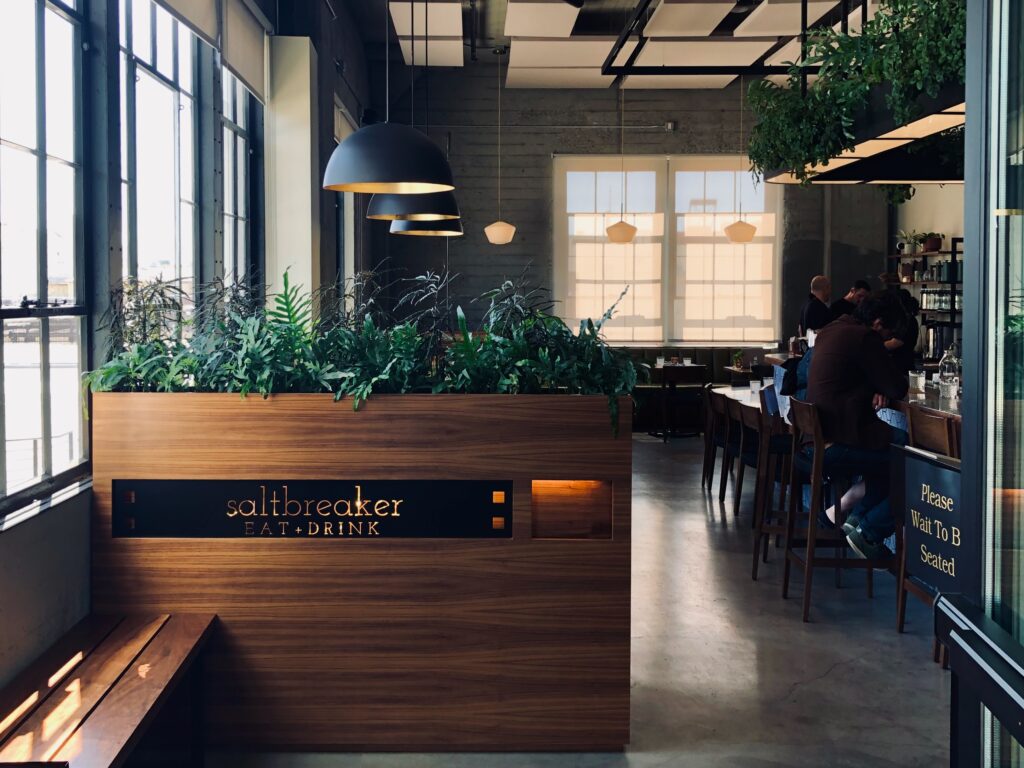There’s a joke in the industry, or maybe it’s a superstition – every restaurant with a Michelin star has an exquisite bathroom. If you’re planning to open a restaurant, you’ve certainly got a lot on your plate. You’ll want someone with adequate experience to design that bathroom and manage many of the other technical aspects along the way. I’ve highlighted 3 important reasons below why you need to hire an architect for your restaurant to increase your chances for success.
Elevate your Restaurant’s Dining Experience
We’ve all had that experience of walking out of a restaurant and feeling a bit dazed. Good restaurants will transport you away from everyday life for a couple of hours and make your return to reality a shock to the senses, in a good way. I call this Dinner and a Show. The dinner is self-explanatory and best left to the chefs. The show is the service and the ambiance. Dial in the food, the service, and the ambiance, and your restaurant can achieve culinary nirvana.
Of course, ambiance is my area of expertise. Like a broken record, I repeat the same two things at my clients over and over. 1. Lighting is the most important part of the design; and 2. Your customers have this ___ at home (fill in the blank – countertops, tile, furniture, etc). Those may sound like strange things to focus on, so I’ll explain them a bit further.
The right lighting can make a red checkered tablecloth the most inviting place to eat on earth. Illuminate the table and dim the surroundings, and all of a sudden your diners are focused on the food, the conversation, and the service. It doesn’t always require incredible surroundings to create an intimate and memorable experience if the lighting is focused on what’s important. Lighting can be fairly simple, but the best lighting is theatrical. It’s punching up the action or the concept of the restaurant – the bartender working her magic, an open kitchen, or a feature wall. Think of the dining room as a theater, where the guests are part of the play.
My other bit of advice, Your customers have this at home, is a reminder to elevate the finish materials and furniture selections. The point is this – your customers have left the comfort of their home in search of a different experience. If aspects of your restaurant remind them of home, it’s just not as unique and exciting. Whenever possible, avoid using typical residential materials like quartz countertops, inexpensive subway tile, or furniture from common showrooms.
Permitting your Restaurant
Permitting is the least fun topic but also the most critical to your ROI and timeline to open. Permitting for a restaurant, in my experience, is one of the most challenging steps for restauranteurs. The process is often long and it can be difficult to understand why. We’ll wait weeks and weeks for any progress to be made by the governing agencies.
The reality is, it is a complex dance between the health department, building department, and the design team. There are often requests for additional information, or “plan check comments” from each department. Your architect and other consultants need to coordinate to respond to these comments, and then submit revised drawings. This is known as a “plan check response”. Once the revision is submitted, the waiting game begins again. With any luck you’ll be issued your permit.
Getting through these hoops takes an architect experienced in working with the various regulatory agencies. When your timeline to open is such a critical part of profitability and success, you want to know that your architect can navigate these agencies and minimize the number of plan check comments and responses. Time lost is not worth the money saved by hiring a less experienced architect.
Custom Details
The details of your dining room are a further expression of your unique dining experience. Just as you should avoid using materials you might find at home, custom details will elevate the experience and delight your patrons. This includes things most people won’t try at home, like bold colors and patterns, industrial materials, or even your logo in neon to capture attention.
Architects are trained to understand balance, scale, materiality, and assemblage. It is nearly impossible to convey how to assemble custom elements without drawing them out. In that regard, it’s understandable how a restaurant built without an architect could feel pedestrian and simple. When there is nobody capable of detailing how to fabricate elements in a unique way – countertops, tables, tile, shelving – they will inevitably be off-the-shelf.
On the flip side, custom details for restaurants that are unexpected will be delightful to your guests. A curved bartop can establish a softer, more inviting approach to the bar. Extra chunky wood dining tables add a touch of luxury and permanence. A pop of color in a hallway can be enough to suggest the way to the bathroom.
Of course, there are other details outside of what an architect does that are as important to the overall experience and should not be overlooked. Dinnerware, logo, and your music playlist will all contribute to the vibe. I would strongly suggest that you still consult with your architect on some of these items as well. After all, your brand experience will be judged on the overall cohesion of style. Finding the right architect is one of the most critical decisions you will make at the start of your new restaurant.

